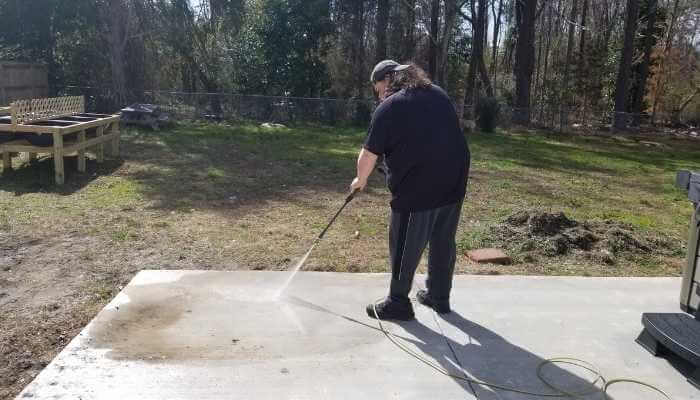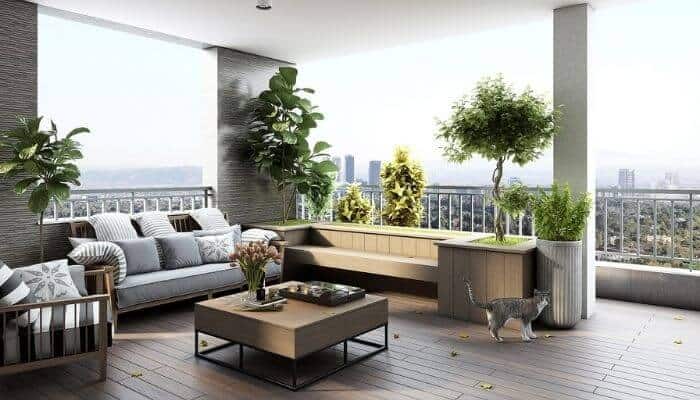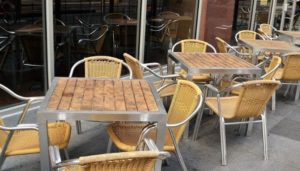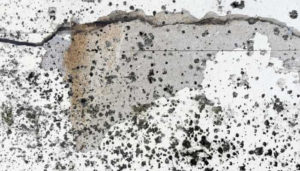
Most of the wicker furniture made today is not the same kind of thing that we grew up with. Most old wicker furniture was made with rattan, willow, or bamboo and It’s not known to be very durable. But today’s wicker furniture is usually made with all-weather resin. It can last upward of 15 years, so long as you take care of it.
Extending the life of wicker furniture will require bi-monthly cycles of cleaning with mild cleansing agents, such as soap, and the application of protective oils on the wicker. It is also advised to limit exposure to the elements using furniture covers or keeping wicker in the shade.
First things first, before you buy, be sure you get the resin or synthetic version if at all possible. Just in case you get a natural material for your wicker furniture’s basic material, I’ll go over the care for both.
What are the Differences Between Natural and Synthetic Outdoor Wicker Furniture?
Just know that when someone mentions “wicker” it doesn’t necessarily refer to the material, but the weave of that material. Wicker is a type of woven form – sometimes artwork, sometimes usable things (baskets), and sometimes furniture.
Our focus is on wicker furniture made out of natural materials such as rattan, willow, reed, or bamboo, and wicker made from synthetic resin or vinyl.
Natural Wicker Furniture – Since natural wicker is made out of wood-like material, it inherits a lot of the problems that come with any natural material. It can break down due to moisture from rain or snow. You’ll have to regularly apply a sealant or finish to keep natural wicker furniture intact.
Antique Wicker Furniture – which is made for indoor more than outdoor use, is often made from natural materials. There is age and wear that you may not be aware of when dealing with this kind of wicker, therefore, it’s more delicate than any other. Handle these pieces with care – they may be worth more than you think.
Synthetic Wicker Furniture – Unlike natural wicker furniture, synthetic, outdoor, wicker furniture usually has aluminum frames. The combination of the aluminum and the synthetic (vinyl or resin) keep the wicker look but provide a much more hardy furniture. It will last longer outdoors despite sunlight and moisture.
No matter which type, the craftsmanship of wicker furniture can greatly affect its durability. If there are any parts that weren’t properly woven, those loose spots may unravel with wear and tear. It’s important to keep an eye out for such issues and repair them immediately or get a professional to do so.
Wicker is also very light, so it shouldn’t be left out where the wind is rough – it could get blown around and damaged. But what else should the owner of wicker furniture be concerned about?
How Often Should Wicker Patio Furniture Be Cleaned?
You should clean both types of wicker furniture regularly. I would say every other month while it is being used and more frequently if there has been a lot of use or spills or pollen or dirt around.
What is the Best Way to Clean Your Wicker Furniture?
Natural Wicker
You can use a vacuum cleaner with a brush attachment to remove dust from the crevices. Brush away any debris. I’ve been known to use canned air (you know, the kind for your computer and accessories?) to get rid of dry debris stuck in the weave.
Then, use a moist cloth to finish the cleaning. For heavily soiled furniture, you can use a mixture of mild soap and water. Just use a sponge or a soft brush to reach difficult areas, and then dry it with a damp cloth.
If there seems to be some grime that’s stubborn, you can always add a couple of tablespoons of apple cider vinegar or even ammonia to your mixture of warm, soapy water. Also, an oil-based soap might work.
No matter what, never sit in wet or damp natural wicker – because the shape will mold to you. And that’s definitely not what you want.
Synthetic Wicker
When it comes to synthetic wicker, you begin much the same way – with your vacuuming. You also want to wipe or brush away any debris that’s hanging around. While specialty products exist for cleaning vinyl, natural solutions can be the most effective and non-damaging. Regular soap and warm water will work on most materials.
Again, it’s best to let the wicker dry completely before using it. Though it’s more durable than natural wicker, it can still stretch.
How to Restore Wicker Outdoor Furniture that is Mildewed or Faded
Wicker furniture is prone to mildew. So, keep some oil soap around for getting rid of that nuisance. And when you’re finished with any cleaning, get the wicker dry as soon as possible, to discourage mildew from returning. Place it under the sun or preferably under a fan.
If your wicker becomes faded over time or dry-looking, you can easily restore it with linseed oil. Just be sure to not go overboard, wipe off any excess, and of course, let it dry. If you must use them before the oil is completely dry, use cushions or the oil will get on your clothing.
There may come a time when you can only restore your wicker furniture by giving it a full makeover.
Or perhaps you’ve bought used wicker furniture or inherited it? You’ve tried everything listed above and it’s just not working out. In that case, you’ll want to prep and paint your wicker furniture.
Only do this if it’s not antique. Yes…there are antique pieces of wicker furniture and artwork out there! And if it’s meant to be its natural color, painting it can decrease the value.
The best linseed oil that we have tried and recommend would be the LinSheen Boiled Linseed Oil.
How to Protect Your Wicker Outdoor Furniture
Protect both natural and synthetic furniture by using some common sense. The skin’s natural oils can be damaging to any plastic or wood furniture, so keep contact minimal. This means using a towel when sitting or lying on it.
Remember to store it or cover it when it’s not in use. That being said, there are also furniture covers available for a reason. They are generally waterproof and UV-resistant. But anything (including a tarp) that can keep dust, dirt, and environmental damage from happening is a bonus.
Remember to periodically check the frames for the need to be tightened and the underside of the wicker for any issues – unraveling for instance. You can usually get with the manufacturer about these issues.
Oiling at least every season gives your furniture another layer of sealant protection from the elements, so don’t forget to do that.
How Long Will My Wicker Patio Furniture Last?
Even with proper maintenance, natural wicker furniture may only last around 5 to 10 years. Resin wicker normally lasts 15+ years, so long as it’s taken care of. It just needs the appropriate protection and maintenance to keep it looking good.
Just keep in mind that since wicker usually needs cushions to be comfortable, that’s another item you’ll have to clean and maintain when using this furniture.
In Closing
If you want your furniture to look good and stay clean for all the years you want to use it, you’ll need to go by what I call the 3Cs: Clean it, Coat it with protectant, and Cover it when not in use.
For anyone still looking at which outdoor furniture lasts the longest then be sure to check out our other article here.














